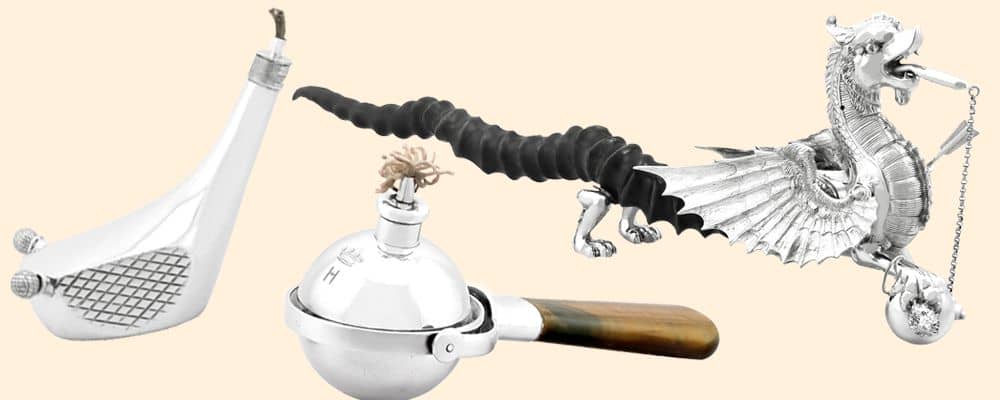Antique Lighters
Vintage and Antique Lighters for Sale
Shop our impressive collection of antique sterling silver lighters for sale at AC Silver. Our collection includes silver lighters from many eras including Victorian, Georgian and Edwardian times.
All lighters purchases will arrive with a complementary insurance valuation and will include free global shipping.
Andrew Campbell, using his 40 years’ experience within the antique silver industry, handpicks all silverware for sale.

Antique Lighters Frequently Asked Questions
A lighter is a portable device used to create a flame. The lighter consists of a metal or plastic container. The container is filled with a flammable liquid or pressurised liquid gas, which is simply a means of ignition to start the flame. There is also some provision for extinguishing the flame.
During the 19th century there was an increased focus on creating self-igniting friction matches. There was also a focus on developing lighters.
Before the pocket lighters people had to rely on tinder boxes and then vesta cases. Vestas were made from thick cotton threads dipped in paraffin wax. They had with a phosphorus head would ignite when rubbed against roughened serrations.
It is said that one of the first lighters to be invented was by a German chemist called Johann Wolfgang Döbereiner in 1823. It was often referred to as Döbereiner’s lamp. The lighter/lamp worked by passing flammable hydrogen gas, produced within the lighter, over a platinum metal catalyst. This in turn would cause it to ignite and give off heat and light. Unfortunately, the lamp was very large, hard to use and also highly dangerous. Thus it didn’t remain popular.
The development of lighters continued through the 19th century. Pocket lighters made an entrance during the late Victorian era. These were hollow and filled with fuel, which was then absorbed by a cotton wick. This model used a sparking flint mechanism. Victorian lighters were predominantly crafted in brass however silver lighters were also found.
Ferrocerium (sometimes misidentified as flint) was patented by Carl Auer von Welsbach in 1903. This made a lot of modern lighters possible. When scratched the material produces a large spark which is responsible for lighting the fuel for lighters.
Using Welsbach’s ferrocerium, companies like Ronson were able to develop practical and easy to use lighters. Fine examples are the Pist-o-liter (1910) and Wonderlite (1913).
By the 1920s and 30s many lighters were crafted in the iconic Art Deco style. Some of these examples would even be inset with a tiny watch.
In 1932 a very famous brand called "Zippo” was founded by George G. Blaisdell, and their lighter became an instant success. They claimed to have unmatched reliability, wind-proof flames and lifetime warranty. It remains highly popular round the world even today.
The first truly automatic lighter came in 1926, from the Ronson Company. The model called "Banjo” enabled users to press a button which created the flame, and then when the button was released the flame was extinguished.
By the late 1920s, there were four main types of lighter in use: manual, automatic, semi-automatic, and striker lighters.
During the late Victorian and early Edwardian periods table lighters increased in popularity. Often crafted in various unusual shapes, but frequently made to resemble Roman lamps. Eccentric ornamentation was often added to these pieces; for example, a twisting serpent handle, or a flame effect. They were also sometimes crafted in more comical shapes such as kids’ comic style bombs and grenades. They would have a tiny wick holder from which to light your cigar.
Although table lighters were commonly crafted in silver, they could often feature other materials such as antelope horn (the most popular type were the spiralling horns of the Indian black buck). Some examples were also mounted on ivory wheels so that they could be pushed down the table without causing any scratches to the surface.











